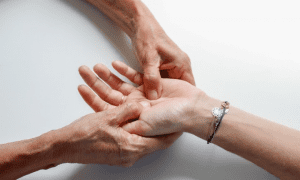
Rheumatoid arthritis is a chronic, progressive disease that causes inflammation and damage to the joints. The disease can also affect other parts of the body, including the skin, eyes, lungs, and heart.
Rheumatoid arthritis is an autoimmune disease, which means that the body’s immune system mistakenly attacks its own tissues. In people with rheumatoid arthritis, the immune system attacks the lining of the joints, causing inflammation. Over time, this inflammation can damage the joint tissues and cartilage, leading to joint deformity and disability.
There is no known cure for rheumatoid arthritis, but treatments are available to help reduce inflammation and pain, and slow the progression of the disease.

How to treat rheumatoid arthritis
The best treatment plan for each person will vary depending on their individual circumstances. However, some of the most common approaches to treating RA include:
1. Taking medications
One of the main treatments for RA is taking medication, which can help to reduce inflammation and pain. There are a range of different medications available for RA, including anti-inflammatory drugs, painkillers, and biologic therapies.
2. Exercising regularly
Exercising regularly can help to improve symptoms of RA by strengthening the muscles and joints. It is important to start slowly and build up gradually, as overexerting oneself can worsen symptoms. Low-impact exercises such as swimming or biking are ideal for people with RA.
3. Maintaining a healthy weight
Maintaining a healthy weight is important for people with RA, as being overweight or obese can put extra strain on the joints and worsen symptoms. A healthy diet and regular exercise are key to maintaining a healthy weight.
4. Using heat or cold therapy
Using heat or cold therapy can help to relieve pain and inflammation in the joints. Heat therapy can be done using a hot water bottle or heating pad, while cold therapy can be done using an ice pack or cold compress.
5. Taking supplements
There are a number of supplements that may help to improve symptoms of RA, including fish oil supplements, glucosamine supplements, and turmeric supplements. Talk to your doctor before starting any new supplements.
6. Seeing a physical therapist
Seeing a physical therapist may also be beneficial for people with RA, as they can provide exercises and stretches that can help to improve flexibility and mobility. Physical therapy can also help to reduce pain and inflammation.
7. Trying complimentary therapies
Finally, complementary therapies such as acupuncture or massage may also be helpful for people with RA. Talk to your doctor about whether these therapies might be suitable for you.
- Watermelon Seeds as a Natural Remedy for High Blood Pressure- Better Cardiovascular Health HubHigh blood pressure, also known as hypertension, is a growing concern globally due to its association with various health complications. While there are pharmaceutical treatments..
- Meditation and Yoga for Arthritis Pain: 20 Practices to Try – Better Holistic Medicine
- Ensuring you get enough sleep is crucial for maintaining your overall health. Learn why sleep is important and how you can improve your sleep habits. – Better Holistic HealthSleep is one of the most essential aspects of maintaining a healthy lifestyle. From improving your memory and focus to regulating your mood and immune..
- Have you ever wondered what the difference is between a balanced diet and a crash diet – Better Holistic HealthWhen it comes to losing weight and maintaining a healthy lifestyle, people often turn to various diets to achieve their goals. However, there is a..
- Did you know that stress is one of the leading causes of weight gain? Learn how to manage stress and maintain a healthy weight with these tips – Better Holistic HealthStress has become a common part of our lives today, with most of us experiencing it in one form or another. Whether it’s work-related stress,..

Thank you for your help and this post. It’s been great.
Thanks
Thanks for posting. I really enjoyed reading it, especially because it addressed my problem. It helped me a lot and I hope it will help others too.
Thanks